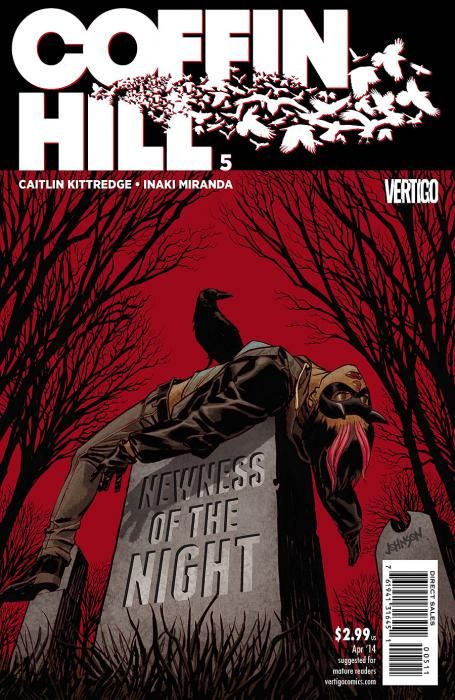Five issues in, "Coffin Hill" still falls just short of being memorable. There are so many elements to like, but the execution continues to feel inadequate. Kittredge and Miranda are very skilled at creating buildup and mystery, something that even some of my favorite series fail to achieve, but when they flesh out the backstory or the characters, the results are often disappointing. I'm still curious about what happened in the woods ten years ago and why, so this series hasn't lost me yet, but it's going to need a knockout issue pretty soon.
This month, Eve tries to deal with whatever monster is possessing Mel, while flashbacks reveal more about her past relationship with Nate. The focus of this flashback is a perfect example of how strange and ineffective Kittredge's plotting choices can be. Since Nate is alive and himself, the reader can see his relationship with Mel build and expand in the present. He doesn't need the weight of the past to do that for him. Meanwhile, Dani and Mel, whom Eve repeatedly says she loved "like sisters," are dead and possessed. They desperately need to be developed in the past, so that their loss, Eve's pain and the consequences of that night can be fully understood.
Instead, Kittredge devotes all this time to Nate. As a result, it's hard to believe that Eve ever loved Mel, when their only meaningful onscreen interactions are battling one another and fighting over a boy. Not only that, but it means there's no pain associated with the body-snatcher element of the series. Since I don't know who Mel was, I have no idea what was lost when she went away. This is disappointing, because on the surface Kittredge has created something wrenching and interesting. Eve's friend, whom she thought was lost to madness, finally comes home -- but only because she's possessed. Eve now has to lose her all over again, and somehow find the strength to kill whatever is in her body. It's complex and painful, and yet it reads like a generic succubus story.
Though the story struggles in this way, Miranda and Cruz's work on art is still a highlight of the series. Cruz's coloring choices may be obvious, but they're so evocative. I grew up in suburban Massachusetts, and I'm impressed that she can really capture the feel of woodsy, grungy teenage New England. She also cues the various moods of the story very clearly, which is essential in a book that jumps around so much. Eve's confrontation with Mel is washed in a cold, bleak blue that adds much-needed weight to the otherwise generic dialogue.
When it comes to dramatic scenes, though, Miranda shines. He creates some truly amazing set pieces. I always look forward to "Coffin Hill" splash pages. However, the storytelling of his panels leaves something to be desired. There are a lot of leaps in the action that don't make sense. Both the perspective and the characters' positions will change without any clear path from one point to the other. That makes it difficult to follow movements panel to panel. If "Coffin Hill" is going to have many more fight scenes, that's something Miranda needs to fix.
In short, "Coffin Hill" is easy to like but tough to invest in. It can skate by on its laurels -- the concept, the atmosphere, the "wow" moments -- for a few more issues, but it's going to need to develop its mythology and its protagonists better if it wants to stick around for the long-term.

